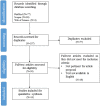Gender differences in vitiligo: psychological symptoms and quality of life assessment description
- PMID: 38187434
- PMCID: PMC10769495
- DOI: 10.3389/fpsyg.2023.1234734
Gender differences in vitiligo: psychological symptoms and quality of life assessment description
Abstract
Objective: Assuming that the difference exist in the manifestation of psychological suffering among genders, the purpose of this review is to summarize the current knowledge on gender differences in vitiligo quality of life and psychological assessment.
Methods: We searched in PubMed, Scopus, and Web of Science databases for original articles in English language. Results were screened according to the Preferred Reporting Items for Systematic Reviews and Meta-Analyses (PRISMA checklist).
Results: The study yielded 107 results; 12 articles have been evaluated as eligible. Each eligible study has been screened and analyzed. The study's qualitative evaluation revealed that 8 papers were classifiable as satisfactory, 4 were classifiable as unsatisfactory. The agreement between the coders was high (% agreement = 84.6%; Cohen's kappa = 0.79). All considered researches (100%) were cross-sectional studies, based on self-report questionnaires. From our analysis, women with vitiligo had a higher risk to experience lower quality of life, and worse mental health in a wide range of psychopathology symptoms than men. A wide heterogeneity of tools is used to investigate the quality of life and psychological symptoms among these patients.
Conclusion: Unfortunately, there are few explanatory models proposed in the literature to rationalize these findings. It will be important to investigate in further researches the specific influence of known risk factors for psychopathology in this population to better explore these phenomena.
Keywords: gender differences; literature review; psycho-dermatology; psychology assessment; quality of life assessment; skin disease; vitiligo.
Copyright © 2023 Samela, Malorni, Matarrese, Mattia, Alfani and Abeni.
Conflict of interest statement
The authors declare that the research was conducted in the absence of any commercial or financial relationships that could be construed as a potential conflict of interest.
Figures
Similar articles
-
Behavioural modification interventions for medically unexplained symptoms in primary care: systematic reviews and economic evaluation.Health Technol Assess. 2020 Sep;24(46):1-490. doi: 10.3310/hta24460. Health Technol Assess. 2020. PMID: 32975190 Free PMC article.
-
Beyond the black stump: rapid reviews of health research issues affecting regional, rural and remote Australia.Med J Aust. 2020 Dec;213 Suppl 11:S3-S32.e1. doi: 10.5694/mja2.50881. Med J Aust. 2020. PMID: 33314144
-
A systematic review of the effectiveness of therapeutic interventions on quality of life (QoL) for adult vitiligo patients.JBI Libr Syst Rev. 2010;8(29):1169-1201. doi: 10.11124/01938924-201008290-00001. JBI Libr Syst Rev. 2010. PMID: 27820500
-
Health-related quality of life in early breast cancer.Dan Med Bull. 2010 Sep;57(9):B4184. Dan Med Bull. 2010. PMID: 20816024
-
Non-invasive skin measurement methods and diagnostics for vitiligo: a systematic review.Front Med (Lausanne). 2023 Jul 27;10:1200963. doi: 10.3389/fmed.2023.1200963. eCollection 2023. Front Med (Lausanne). 2023. PMID: 37575985 Free PMC article.
Cited by
-
Insights into human melanocyte development and characteristics through pluripotent stem cells combined with single-cell sequencing.iScience. 2025 Apr 8;28(5):112373. doi: 10.1016/j.isci.2025.112373. eCollection 2025 May 16. iScience. 2025. PMID: 40641554 Free PMC article.
-
Association Between Serum and Intraerythrocyte Zinc Levels and Vitiligo Disease Activity: A Clinical Study.Biol Trace Elem Res. 2025 Sep;203(9):4561-4567. doi: 10.1007/s12011-025-04536-x. Epub 2025 Feb 20. Biol Trace Elem Res. 2025. PMID: 39976885
-
Clinical patterns of vitiligo in Japan: A descriptive study using the JMDC claims database.J Dermatol. 2025 May;52(5):831-840. doi: 10.1111/1346-8138.17627. Epub 2025 Jan 20. J Dermatol. 2025. PMID: 39831416 Free PMC article.
-
An Overview of the Biological Complexity of Vitiligo.Oxid Med Cell Longev. 2024 Dec 19;2024:3193670. doi: 10.1155/omcl/3193670. eCollection 2024. Oxid Med Cell Longev. 2024. PMID: 39735711 Free PMC article. Review.
-
Assessment of the Quality of Life of Vitiligo Patients: A Cross-Sectional Study in the Eastern Region of Saudi Arabia.Cureus. 2024 Jul 31;16(7):e65873. doi: 10.7759/cureus.65873. eCollection 2024 Jul. Cureus. 2024. PMID: 39219933 Free PMC article.
References
-
- Abeni D., Picardi A., Puddu P., Pasquini P., Chren M. M. (2001). Construction and validation of the Italian version of Skindex-29, a new instrument to measure quality of life in dermatology. G. Ital. Dermatol. Venereol. 136, 73–76.
-
- Al Robaee A. A. (2007). Assessment of quality of life in Saudi patients with vitiligo in a medical school in Qassim province, Saudi Arabia. Saudi Med. J. 28, 1414–1417. PMID: - PubMed
-
- Alikhan A., Felsten L. M., Daly M., Petronic-Rosic V. (2011). Vitiligo: a comprehensive overview: part I. Introduction, epidemiology, quality of life, diagnosis, differential diagnosis, associations, histopathology, etiology, and work-up. J. Am. Acad. Dermatol. 65, 473–491. doi: 10.1016/j.jaad.2010.11.061 - DOI - PubMed
LinkOut - more resources
Full Text Sources


